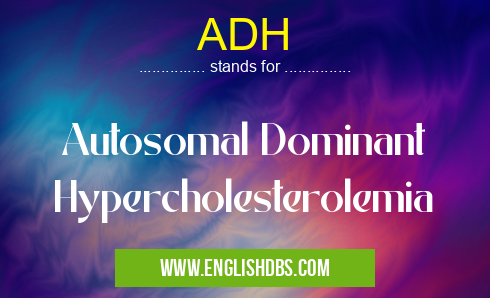What does ADH mean in UNCLASSIFIED
ADH (Autosomal Dominant Hypercholesterolemia) is a genetic disorder that affects the way the body metabolizes cholesterol. It is inherited in an autosomal dominant manner, meaning that only one copy of the affected gene is needed to cause the condition.

ADH meaning in Unclassified in Miscellaneous
ADH mostly used in an acronym Unclassified in Category Miscellaneous that means Autosomal Dominant Hypercholesterolemia
Shorthand: ADH,
Full Form: Autosomal Dominant Hypercholesterolemia
For more information of "Autosomal Dominant Hypercholesterolemia", see the section below.
Causes
ADH is caused by mutations in the LDLR gene, which codes for the low-density lipoprotein (LDL) receptor. LDL is the "bad" cholesterol that can build up in the arteries and cause plaque, which can lead to heart disease and stroke. In people with ADH, the LDL receptor is either defective or missing, which prevents the body from removing LDL from the blood.
Symptoms
ADH is a progressive disorder, meaning that the symptoms tend to get worse over time. In the early stages, there may be no symptoms. However, as cholesterol levels rise, people with ADH may develop:
- Xanthelasma: Yellowish plaques around the eyes
- Arcus cornealis: A white ring around the cornea
- Tendinous xanthomas: Yellowish bumps on the tendons
- Cardiovascular disease: Heart attack, stroke, and peripheral artery disease
Diagnosis
ADH is diagnosed based on a physical examination, family history, and blood tests. The blood tests will measure cholesterol levels, including LDL, HDL (the "good" cholesterol), and triglycerides.
Treatment
There is no cure for ADH, but there are treatments that can help lower cholesterol levels and reduce the risk of heart disease. These treatments include:
- Statins: Medications that block the production of cholesterol in the liver
- Ezetimibe: A medication that blocks the absorption of cholesterol in the intestines
- PCSK9 inhibitors: Newer medications that help the liver remove LDL from the blood
- Lifestyle changes: Eating a healthy diet, exercising regularly, and maintaining a healthy weight
Essential Questions and Answers on Autosomal Dominant Hypercholesterolemia in "MISCELLANEOUS»UNFILED"
What is Autosomal Dominant Hypercholesterolemia (ADH)?
Autosomal Dominant Hypercholesterolemia (ADH) is an inherited condition that causes high levels of cholesterol in the blood. It is caused by a mutation in the LDLR gene, which is responsible for removing LDL (bad) cholesterol from the body.
What are the symptoms of ADH?
ADH often does not cause any symptoms. However, high cholesterol levels can lead to the formation of fatty deposits in the arteries, which can increase the risk of heart disease and stroke.
How is ADH diagnosed?
ADH is diagnosed through a blood test that measures cholesterol levels. Genetic testing can also be used to confirm the diagnosis.
How is ADH treated?
Treatment for ADH typically involves lifestyle changes, such as a healthy diet and exercise, as well as medication to lower cholesterol levels.
What are the long-term risks of ADH?
High cholesterol levels can increase the risk of heart disease and stroke. ADH can also lead to other health problems, such as peripheral artery disease, pancreatitis, and kidney disease.
Is ADH curable?
There is no cure for ADH, but treatment can help to lower cholesterol levels and reduce the risk of complications.
Can ADH be prevented?
ADH is an inherited condition, so it cannot be prevented. However, lifestyle changes can help to lower cholesterol levels and reduce the risk of complications.
How common is ADH?
ADH is a relatively rare condition, affecting about 1 in 500 people.
Final Words: ADH is a serious genetic disorder that can lead to heart disease and stroke. However, with early diagnosis and treatment, people with ADH can live long and healthy lives.
ADH also stands for: |
|
| All stands for ADH |
